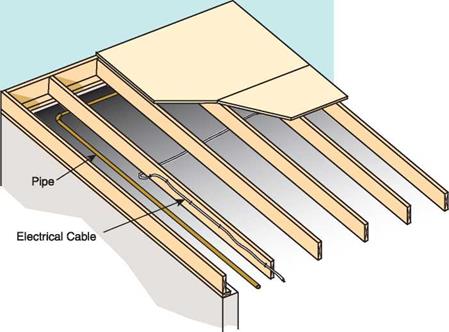Whether you are working with new construction or a remodeling project, special structural considerations may be necessary for many different installations. Again, your building contractor may be well aware of these issues, but careful planning or a careful examination of the current structural components in the bathroom will be critical when making decisions about design options. You can begin with the original construction plans as a guide, but eventually you will need to verify that the structure is actually built as indicated on the plans. Chapter 5 has useful information, forms, and checklists to help you gather information about the existing structure. Form 6: Jobsite Inspection will be especially useful to inspect the structure.
Following are some of the structural considerations to keep in mind.
Floor Structures
Whenever the floor will be changed in some manner during your remodeling project, it is important to know more about the floor structure and what is hidden within that floor. Once you have verified the direction and size of the floor joists or floor trusses, it is essential that you know what components are already within the floor structure so that you do not damage them during the remodeling process. Concealed air ducts or plumbing may be difficult and expensive to relocate. After this inspection you will have a better idea of how to proceed with plans for new plumbing, wiring, or heating components that need to be placed in the floor. An examination of structural components will also help you determine the floor strength.
When locating a toilet in a new bathroom, floor framing must take into account the toilet placement so that the waste pipe can be properly installed between the joists in the floor (see Figure 2.1). If you are remodeling and plan to move the toilet location, the waste pipe may need to be relocated, depending on the distance it is moved. This may be a very difficult and expensive process. When only a small adjustment needs to be made in order for the toilet to line up with the waste drain, an offset flange attachment can allow you to move the toilet as much as 2 inches (51 mm), code permitting of course, in order to make use of the current waste drain. Roof venting may also need to be adjusted, so check to see what that may involve.
Damage
Check for any water damage that may have weakened the floor structure. Leaking toilets or pipes can cause structural supports to deteriorate over time, and often this damage goes undetected
 |
 |
because it is hidden by a floor covering. Lifting or removing the floor covering or checking for possible evidence of water damage on the ceiling directly below the bathroom will give clues to such damage.
If the damage is severe, subflooring materials or even floor joists may need to be replaced or reinforced. To prevent some of these problems in the future, seal the floors to prevent moisture from reaching the subflooring and joists. This is especially true around toilets, tubs, or showers.
The floor covering may serve as the seal if it is made of a material that water cannot penetrate and is caulked at the joints and seams. Special concrete or other poured floors may be a better choice for sealing out water as well as providing additional floor stability. Along with the structural damage, you may find mold inside the floor area where moisture was trapped. Chapter 3, "Environmental and Sustainability Considerations," discusses mold in greater detail.
Another type of damage prominent in warmer climates is termite damage. If the home has not been inspected for termites, then this would be important to recommend to your client. If the home has a history of termite infestation or if close neighbors have termites, an inspection should be completed before you begin the remodeling project. Termites can cause a tremendous amount of damage to the structure, so eliminating the threat and correcting the damage will provide a high-quality structure for your new project.



